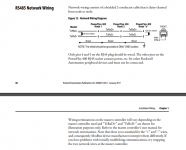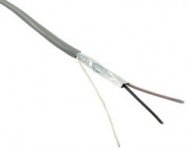TwoBlocked
Senior Member
- Location
- Bradford County, PA
- Occupation
- Industrial Electrician
So I am upgrading a PLC cabinet. The decision was made to control a couple VFD pumps with modbus on a RS-485 network. I knew this Allen-Bradley Powerflex 400 had onboard RS-485, so I use a spare analog cable and pull in a 4 conductor Belden like usual. THEN I look to see where to land the wires. What the ... I have to use the RJ-45 port, with the SHIELD going to a screw terminal? I call up the manual and it says I have to use only positions 4 & 5 on the RJ-45 plug because other positions are used for other functions. The manual also gives the typical RS-485 layout, including daisy chaining and end of line resistors. Ok ... now how would I daisy chain with RJ-45 connectors let alone install EOLs ??? Not to mention landing the SHIELD at a field device instead of just the PLC cabinet. And gee wizz! I have CAT 5E cable, but it doesn't have a shield anyway. And the comm port on the controller isn't RJ-45, it's wire terminals!
So I did what I could with what I had. Used the 4 conductor Belden to pull CAT 5E, put on a connector with just two wires in the positions called for, kept the solid green to go to the "shield" terminal (I'd call it 0 volt reference ...), and landed these three flimsy 24 ga solid wires on the controller's comm port. Felt disgusted so put in just 10 hours instead of the usual 12.
Who else has dealt with this? Is there a better way?
So I did what I could with what I had. Used the 4 conductor Belden to pull CAT 5E, put on a connector with just two wires in the positions called for, kept the solid green to go to the "shield" terminal (I'd call it 0 volt reference ...), and landed these three flimsy 24 ga solid wires on the controller's comm port. Felt disgusted so put in just 10 hours instead of the usual 12.
Who else has dealt with this? Is there a better way?




